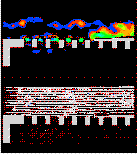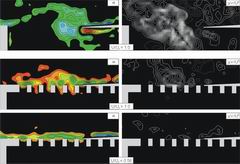You are here
Home ›Oscillations of free shear flow and shear flow along a slotted plate coupled with a resonant mode of a bounding cavity
Oscillations of free shear flow and shear flow along a slotted plate coupled with a resonant mode of a bounding cavity. Resonant-coupled instabilities along the mouth of a cavity are shown in the image layout. The top row of images shows the coupled oscillation of a free-shear flow, and the middle and bottom images represent coupled oscillation of a shear flow along a slotted plate. For both cases, the induced resonant mode of the bounding cavity is the same; it is the first mode in the longitudinal direction. The overall flow configuration mimics self-excited oscillations of an organ pipe. Experiments are performed in a free-surface water facility, such that a resonant acoustic mode in air is simulated by a resonant gravity wave mode in the shallow free-surface layer.
The first row of images shows patterns of instantaneous vorticity ω and Reynolds stress correlation u′v′/U2 of the oscillating free-shear layer, for the case where the inflow (freestream) velocity U is adjusted to the value Ur at which maximum resonant coupling occurs, i.e., U/Ur = 1.0. The pattern of vorticity shows formation of a large-scale cluster immediately upstream of the tip of the impingement edge and, furthermore, substantial transverse deflection of the shear layer that separates from the leading-corner of the cavity. Correspondingly, a region of well-defined correlation u′v′/U2 is evident.
The second row of images shows oscillations in presence of a slotted plate along the cavity opening. As for the images in the first row, the flow velocity corresponds to maximum resonant coupling, that is U/Ur = 1.0. It is evident that a well-defined, large-scale cluster of vorticity exists upstream of the tip of the impingement edge, which corresponds to the effective trailing-end of the slotted plate. The scale, and thereby the circulation, of this large-scale vorticity cluster is, however, not as large as for the free shear layer. Likewise the pattern of u′v′/U2 is not as pronounced.
It is therefore evident, in the second row of images, that long wavelength, well-defined oscillations can occur in a resonant-coupled mode for flow along a slotted plate. If, in fact, this oscillation represents a truly resonant-coupled condition, whereby a state of lock-on exists, then it should be possible to detune the oscillation by adjusting the freestream velocity U to a value away from maximum resonant coupling. The bottom row of images shows the flow structure corresponding to U/Ur = 0.56. It is clear that resonant coupling no longer occurs, and therefore no large-scale clusters of w and u′v′/U2 are indicated.
You can download the movie (2.6 MB avi file), or visit our Cinemas of Flow-Structure Interactions.

Self-excited oscillations of flow past a cavity are generated in a shallow free-surface system. Instability of the shear flow past the cavity opening, both without and with a slatted plate, couple with the longitudinal resonant (free-surface) mode of the adjacent cavity. The instantaneous and time-averaged structure of the unstable shear layer are characterized in relation to the flow within the cavity using a technique of high-image-density particle image velocimetry. These quantitative patterns of the flow include spatial distributions of velocity, vorticity, streamline topology, Reynolds stress correlation, as well as patterns of amplitude peaks and phase angles of the unsteady velocity fields obtained via global spectral and cross-spectral techniques. Use of a cinema version of PIV provides the timewise evolution of instantaneous patterns of the flow. The distinctive, as well as common, features of the coupled instability past a slatted plate are characterized in relation to the instability in absence of the plate, both for varying degrees of resonant coupling between the unstable shear flow and the free-surface resonant mode of the cavity, which is attained through variations of the inflow velocity, and thereby the predominant oscillation frequency in relation to the resonant frequency of the bounding cavity. In essence, when the slatted plate is present, well-defined, coherent oscillations are indeed attainable, though their amplitude is significantly mitigated relative to a case of no slatted plate. The key aspects of the flow structure on either side of, and within, the slatted plate, and the manner in which they vary with geometry of the slat arrangement, are characterized in relation to the degree of organization of the self-excited, resonant-coupled oscillation.

